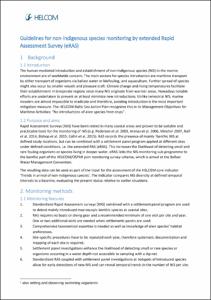| dc.coverage.spatial | Baltic Sea | en_US |
| dc.date.accessioned | 2022-07-12T21:53:22Z | |
| dc.date.available | 2022-07-12T21:53:22Z | |
| dc.date.issued | 2017 | |
| dc.identifier.citation | HELCOM (2017) Guidelines for non-indigenous species monitoring by extended Rapid Assessment Survey (eRAS), Helsinki, Finland, HELCOM, 4pp. DOI: http://dx.doi.org/10.25607/OBP-1801 | en_US |
| dc.identifier.uri | https://repository.oceanbestpractices.org/handle/11329/2006 | |
| dc.identifier.uri | http://dx.doi.org/10.25607/OBP-1801 | |
| dc.description.abstract | The human-mediated introduction and establishment of non-indigenous species (NIS) in the marine environment are of worldwide concern. The main vectors for species introduction are maritime transport by either transport of organisms via ballast water or biofouling, and aquaculture. Further spread of species might also occur by smaller vessels and pleasure craft. Climate change and rising temperatures facilitate their establishment in temperate regions since many NIS originate from warmer areas. Nowadays notable efforts are undertaken to prevent or at least minimize new introductions. Unlike terrestrial NIS, marine invaders are almost impossible to eradicate and therefore, avoiding introduction is the most important mitigation measure. The HELCOM Baltic Sea Action Plan recognizes this in its Management Objectives for Maritime Activities: “No introductions of alien species from ships”.
1.2 Purpose and aims
Rapid Assessment Surveys (RAS) have been tested in many coastal areas and proven to be suitable and practicable tools for the monitoring of NIS (e.g. Pederson et al. 2003, Arenas et al. 2006, Minchin 2007, Nall et al. 2014, Bishop et al. 2015, Collin et al. 2015). RAS records the presence of mainly 1benthic NIS at defined study locations, but can be combined with a settlement panel program applied at different sites under defined conditions, i.e. the extended RAS (eRAS). This increases the likelihood of detecting small and rare fouling organisms or species living in deeper water. eRAS links the NIS monitoring sub-programme to the benthic part of the HELCOM/OSPAR port monitoring survey scheme, which is aimed at the Ballast Water Management Convention.
The resulting data can be used as part of the input for the assessment of the HELCOM core indicator ‘Trends in arrival of non-indigenous species’. The indicator compares NIS diversity at defined temporal intervals to a baseline, evaluating the present status relative to earlier situations. | en_US |
| dc.language.iso | en | en_US |
| dc.publisher | HELCOM | en_US |
| dc.subject.other | Monitoring | en_US |
| dc.subject.other | Non-Indigenous species | en_US |
| dc.subject.other | Indigenous species | en_US |
| dc.title | Guidelines for non-indigenous species monitoring by extended Rapid Assessment Survey (eRAS). | en_US |
| dc.type | Report | en_US |
| dc.description.status | Published | en_US |
| dc.format.pages | 4pp. | en_US |
| dc.contributor.corpauthor | HELCOM | en_US |
| dc.description.refereed | Refereed | en_US |
| dc.publisher.place | Helsinki, Finland | en_US |
| dc.subject.parameterDiscipline | Biota abundance, biomass and diversity | en_US |
| dc.description.currentstatus | Current | en_US |
| dc.description.sdg | 14.a | en_US |
| dc.description.maturitylevel | Mature | en_US |
| dc.description.adoption | Multi-organisational | en_US |
| dc.description.adoption | International | en_US |
| dc.description.methodologyType | Method | en_US |
| dc.description.methodologyType | Specification of criteria | en_US |
| obps.endorsementAuthorDeclared.deJureStandard | HELCOM | |
| obps.contact.contactemail | info@helcom.fi | |
| obps.resourceurl.publisher | https://helcom.fi/helcom-at-work/publications/manuals-and-guidelines/ | |
 Repository of community practices in Ocean Research, Applications and Data/Information Management
Repository of community practices in Ocean Research, Applications and Data/Information Management
